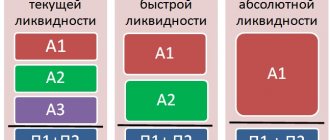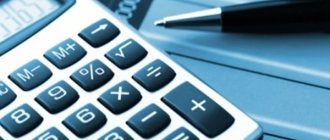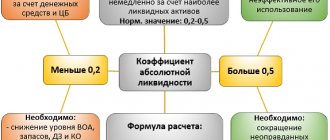Where can I find revenue on the balance sheet?
When a company has been operating for a year, everyone is interested in knowing what its revenue is for this period and what part of it is expenses.
It is by these indicators that one can judge the profitability or unprofitability of its activities. According to all accounting laws, the balance sheet is a snapshot of the company’s performance indicators at a certain reporting date. Searching the balance sheet for a line that would show revenue is useless. No such line exists. To reflect revenue, another important accounting report is used - financial results.
Learn how to read a balance sheet using the example in this material.
However, revenue and balance sheet are related, although this connection is not clearly visible. Let's trace it using the example of individual balance sheet lines.
You can find out which receipts are revenue and which are not from the Guide from ConsultantPlus. Get trial access to the system for free and proceed to the material.
Revenue and 1st section of the balance sheet
Almost every line of the first section of the balance sheet is associated with a revenue indicator. For example, if the residual value of fixed assets or intangible assets decreased sharply during the reporting period, it is possible that some of them were sold. In this case, we can talk about the company’s possible revenue from their sale. If information appears on the balance sheet about profitable investments in material assets, you can expect to receive revenue from an activity such as renting out property.
In the 1st section there are lines that, it would seem, have no connection at all with revenue, for example, financial investments. But it is not so. If a company operates profitably and is interested in its development, it will try to increase the money it earns. Financial investments are one such way. Of course, it is also possible to purchase securities or make contributions to the authorized capitals of other companies using borrowed funds. However, the main source in sustainable developing companies is profit, a significant part of which is revenue.
For information on the specifics of reflecting the company’s assets in the 1st section of the balance sheet, read the article “Procedure for drawing up a balance sheet (example)” .
Step-by-step instructions on how sales income is reflected in accounting in 1C
Finished products
- Creating a document First of all, the accountant must create a document. To do this, we go to the “Sales” subsection of the corresponding menu item. Next, find the item “Sales (acts, invoices)”, go to “Goods, services and commission”.
- Fill out the document. Enter the seller, buyer, warehouse and prices into the required lines.
- Selecting products and adding them to the table By clicking the “Add” button, you can start selecting and adding products to the table line by line. But there is a more convenient option - using the “Selection” option. With its help, you will be able to select goods from those remaining in the warehouse, immediately select quantity and price (if a certain type of price has not been previously specified).
- Posting the document If everything you need is included in the report, find and click the “credit/debit” button located at the top of the document.
Works
- Create a document Find the “Sales” menu, in it click on “Sales”, then on “Goods, services and commission”.
- We fill out the document. The program will highlight the required fields with a red dotted line. Here you need to indicate the organization of the seller, the counterparty and the cost of the work.
- We enter the completed work into the table. Add them manually or use the “selection” option.
- Posting a document The program will automatically create a posting; for this, the user needs to make just one click - on the “debit/credit” button. It is located at the top of the page, above the generated report.
Read more about what the formula for calculating sales revenue looks like and what the general algorithm for determining this indicator is here.
Services
- Create a document In the 1C program, select the “Sales” menu, go to the “Sales” subsection, here we create a document using the “Goods, services and commission” option.
- We fill out the document In the header of our report we add basic information: who provided the service to whom and at what price. Please note that when maintaining records only within one organization, the supplier field will be inactive and will not need to be filled out.
- Selecting services for the report There are two options - through the “add” button and through the “selection” button. We recommend using the second option, then you will have the opportunity to “pull” services from the list reflected earlier in the program.
- Post the document Click on the “debit/credit” button and receive ready-made transactions. If something suddenly goes wrong, you can edit the document manually (the “Manual correction” checkbox).
Revenue and current assets
Information on current assets as of the reporting date is contained in the 2nd section of the balance sheet. In this section, the relationship between revenue and current assets can be traced primarily in the line “Cash and cash equivalents” - it is the company’s revenue that goes to the current account and cash desk.
A significant balance on this line as of the reporting date allows us to judge the methods and skills of managers to work with incoming revenue. For example, a company operates so profitably that it does not have time to immediately put the incoming revenue into new circulation in large volumes (purchase assets, make profitable investments, etc.). A low cash balance can equally indicate both the good work of financial managers, who are able to find the correct use of incoming revenue in a timely manner, and the company’s possible cash shortage.
IMPORTANT! If a company receives revenue at the cash desk, situations cannot be ruled out when the following limits may be exceeded:
- cash settlements between legal entities (directive of the Bank of Russia dated December 9, 2019 No. 5348-U);
- balance of cash in the cash desk (instruction of the Bank of Russia dated March 11, 2014 No. 3210-U).
Such violations may be punishable under Art. 15.1 Code of Administrative Offenses of the Russian Federation.
For more information about the rules that must be followed when working with cash proceeds, read the material “Cash discipline and responsibility for its violation”.
The connection between revenue and this balance sheet item can be traced in detail by studying another accounting report - the cash flow report. But the information from the balance sheet already makes you think.
3rd section of balance sheet and revenue
Unlike other lines and sections of the balance sheet, this section is directly related to the report in which revenue appears. It is from the financial results statement that the amount of net profit received by the company is included in retained earnings and is reflected in the 3rd section of the balance sheet.
There is another relationship between revenue and this section: it is impossible to be a profitable enterprise, form reserves and increase capital in the absence of profit, and profit is unthinkable without revenue.
However, the balance sheet can only show the increase or decrease in overall profit or loss. The components of the profit will be shown by another mandatory reporting document - the financial results report.
The financial results report for 2022 must be submitted using a new form. Line-by-line explanations and examples from ConsultantPlus will help you create a new form 2. Get trial access to the system for free and proceed to the Reporting Guide.
General characteristics and significance of gross profit for production development
Competent management of the production and commercial activities of any enterprise is impossible without regular monitoring of financial indicators.
To monitor the turnover of funds, financial statements are generated. Gross profit is one of the significant indicators of a company's economic potential.
The indicator expresses the financial result of all aspects of the company's activities. The value is reflected in the balance sheet.
The total value expresses the influence of external and internal parameters on the success of the enterprise. For convenience, they are divided into 2 groups.
The first shows the dependence of VP on the organization within production.
Its value is influenced by such parameters as:
- Cost of production.
- Commodity coefficient.
- Volume of production.
- Product quality.
- Degree of utilization of production capacity.
In addition to these intra-production reasons, the increase or decrease in gross profit is influenced by environmental parameters.
Among them are:
- Location of the company.
- Regulatory framework.
- Political and economic situation in the country.
- The natural environment.
Analysis of the parameters that affect the amount of gross profit is necessary to make a decision on the feasibility of a particular type of activity in a particular region. With the help of this tool, profitable or unprofitable areas of business are identified, and guidelines for new ways to solve financial problems are obtained.
What is gross profit and how does it differ from net profit?
Gross profit is considered one of the main indicators characterizing the efficiency of an enterprise. It is calculated as the difference between:
- net revenue from the main activity,
- the cost of goods or services.
Based on the obtained value, one can indirectly judge the profitability of the enterprise. Indirectly - since the indicators taken into account do not reflect complete information.
Thus, the term “net” in relation to revenue means that it is necessary to subtract from it:
- VAT,
- excise taxes,
- other obligatory payments (for example, export duties).
The cost indicator is formed by:
- costs of production and provision of services;
- the purchase price of the goods sold.
Commercial and administrative expenses are not included in the cost price; they are reflected in the financial performance statement separately and participate in the formation of the net profit indicator (clause 23 of PBU 4/99).
Actually, this is the difference between gross profit and net profit. The first serves, rather, to assess production costs, pricing efficiency, and return on production, since it is formed from indicators that are directly related to production.
While net profit is the final financial result of the enterprise’s activities for the reporting period, calculated as the difference between all recognized income and expenses (including taxes and mandatory payments).
Measures to increase gross profit
Calculation of VP, analysis of all its elements, identification of accompanying and impeding factors are aimed at increasing the profitability of the enterprise. Economic theory and practice have in their arsenal tools for increasing gross profit.
Here they are:
- LIFO technique.
- Tax benefits.
- Writing off bad debts.
- Reducing costs.
- Flexibility in pricing.
- Use of high technologies.
- Improving the quality of products and services.
- Increased control over intangible assets.
Help: LIFO method
(
LIFO
) - a method of accounting for inventory in value terms at the price of the last batch manufactured or received. In accordance with this method, inventory items that were registered last are removed from the register first.
Intensification of production processes, the use of high-tech equipment, high-quality raw materials, reasonable organization of labor, and the use of modern technologies are factors that ensure the liquidity of products and, as a result, increase VP.
Gross profit is the amount of money remaining in a company's account after subtracting production expenses. The numerical value is determined by the formula. Calculation details vary depending on the type of business. The indicator is necessary for assessing technological production resources. VP helps to rationally formulate the commodity value of products. The value is reflected in the financial statements through entries approved by order of the Ministry of Finance.
Revenue and debt
Information about the company's borrowed funds is contained in sections 4 and 5 of the balance sheet. The relationship between this information and revenue is very weak, but it exists.
Borrowing money is a dangerous and burdensome operation. Dangerous because there is a possibility of not repaying the debt and even going bankrupt. Burdensome if paying interest on borrowed funds consumes all working capital, and there is no money left for current expenses. There is nothing to buy raw materials, nothing to pay wages and taxes, nothing to pay for electricity and heat, that is, the production process is under threat. As a result, disruptions occur in the supply of finished products to customers. And where there is no sales, there is no revenue.
IMPORTANT! Now companies do not need to standardize interest on borrowed funds for the purpose of calculating income tax (Law No. 420-FZ dated December 28, 2013). This is true for all debt obligations, except those that arose as a result of controlled transactions.
How to correctly calculate net profit?
Net profit formula
- Net profit = total profit – the sum of all expenses. ...
- Net profit = profit before tax - income tax.
24 Jan
2022 Interesting materials:
What kind of soil should there be for anthurium? What should be the speed via Wi-Fi? What should a teacher's assistant's salary be? What is the dose of valerian? What is Basta's last name? Which electrical safety group should the person responsible for electrical equipment in electrical installations with voltages above 1000 have? What icon is needed for a wedding? What information should be on the information board in the store? Which of the following lithospheric plates is the largest? Which quantity is a vector quantity?
Results
There is no line item on the balance sheet to record revenue.
But the amount of the company's assets and liabilities reflected in this main accounting report, as well as their changes, may indirectly indicate an increase or decrease in the company's revenue. And vice versa. Thus, there is a connection between balance sheet indicators and revenue. You can find more complete information on the topic in ConsultantPlus. Free trial access to the system for 2 days.








